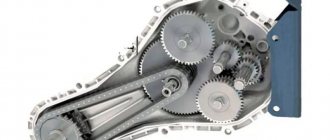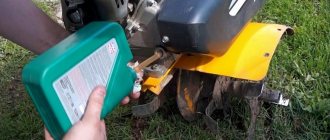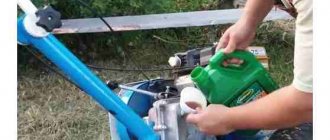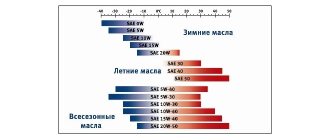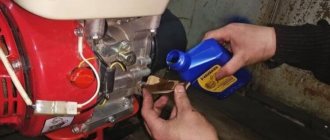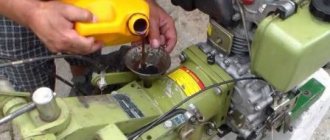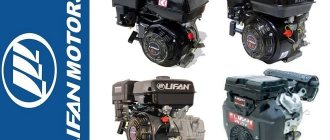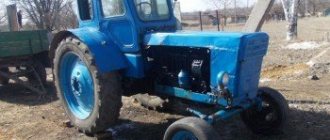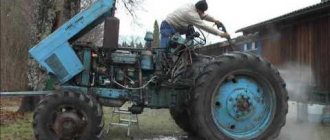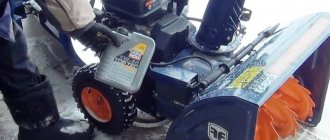Neva is one of the most popular models in its class due to its good quality and relatively low price compared to its competitors. The gearbox on the Neva walk-behind tractor is one of the most important parts. Only high-quality oil is used for the gearbox of the Neva MB 2 walk-behind tractor, since otherwise repair work may be required. Changing the oil has a strict sequence, which must be carried out taking into account all the design features.
Before changing the oil. you need to choose the appropriate oil
Gearbox device
The gearbox for the walk-behind tractor allows the use of additional equipment that receives speed from this mechanism. The device itself and the principle of operation are similar to elements of other models.
Important! When assembling the gearbox of the Neva walk-behind tractor, the design features and device must be taken into account first of all, since if the arrangement is incorrect, the mechanism will not work.
The device is responsible for the rotational transmission that goes from the engine to the wheel system and additional attachments. It turns out that without a mechanism there will be no movement, since it is a control tool for the rotational number, speed and direction of movement.
The design of the mechanism has an element for changing gears. It is located in the upper body part. The lever includes 5 positions in its location. When it is pressed using the fork, the clutch is released from the clutch. If the lever is released, the fork reverses back.
In this video you will learn how to change the oil: To slow down the equipment, the drive is connected to the right-hand axis. Torque is produced from a sprocket located near the input shaft. If the lever is pressed, the left sprocket engages, which leads to a lower gear. For top gear, the knob is set to the limit.
You need to know all the design features when correcting breakdowns and malfunctions.
Multiagro
The Multiagro gearbox is a special version of the mechanism that was patented specifically for the Neva. It has a number of features:
- the number of gears has been increased;
- the gear ratio is increased, which allows for increased traction with little power consumption;
- The wheels (right and left) are separated, which is necessary for a minimum radius when turning. This allows for significantly increased maneuverability;
- resistance to increased loads using a more powerful body, which is reinforced with stiffening ribs on the inside of the body;
- the casing is sealed using a special silicone-based sealant;
- the shape has a streamlined appearance, which reduces resistance when cultivating the soil.
All these features allow the walk-behind tractor to gain additional capabilities that are often unavailable to competitors.
This gearbox was made specifically for the Neva walk-behind tractor
Oil for the Neva walk-behind tractor in the gearbox
The gearbox is one of the most important components of any mechanism, including walk-behind tractors. What type of oil to fill, how often to change, how to check its quantity - every owner of such equipment should know the answers to all these questions. Before purchasing oil, read the operating instructions for the unit. There the manufacturer gives his recommendations, which are the most accurate and recommended.
Type of oil for different models of walk-behind tractors:
- The following oil is suitable for the Neva walk-behind tractor MB 1: transmission TEP-15 according to GOST 23652-79, TM-5 according to GOST 17479.2-85. You need to fill in a volume of 2.2 liters;
- for the Neva unit, MB 2 is suitable according to GOST 23652-79, such as TAP-15V or TAD-17I.
For the normal operation of the gearbox, not only the choice of a reputable oil manufacturer is of great importance, but also replacing it in a timely manner. It needs to be replaced regularly, at certain intervals. This will extend the life of the gearbox. We offer you some tips on how to replace it:
- The walk-behind tractor must be strictly vertical;
- Place a large container (at least 3 liters) under the product;
- Unscrew the breather and clean it;
- Unscrew the screw and drain all the oil;
- Tighten the screw into place;
- Fill in new clean oil with the required amount;
- Close the breather;
- Check the functionality of the equipment.
There are still some points that you should know before you start working on the walk-behind tractor. As you know, the unit needs to be run in for some time. After approximately 30-35 hours of break-in, you should replace the oil with new oil. After this, the oil should be changed every 150-200 hours of operation, and if you do not use the equipment, then every 1-2 years.
Many consumers ignore these recommendations, and the oil itself tends to age. Consequently, breakdowns may eventually occur. If you value your equipment, do not ignore the manufacturer's recommendations.
Classification of oil grades
To increase the service life of a gasoline or diesel engine, you need to make the right choice of engine oil. Failure to replace it in a timely manner reduces the service life of the engine. How to choose it, in what quantity, how to pour it into the walk-behind tractor - we’ll talk about this in more detail.
Each mini-tractor or walk-behind tractor includes instructions and a product data sheet. In the instructions, the manufacturer lists suitable types of fuel and lubricants that can extend the life of the equipment. Engine oil performs the following functions:
During air cooling, the lubricant settles on the walls of the hot cylinder. These deposits contaminate engine parts and complicate lubrication processes. Therefore, the lubricant contains antioxidant additives. They clean the cylinder walls from carbon deposits and extend the service life of the walk-behind tractor. Different climate zones require the use of different oily liquids. They differ in viscosity, composition and purpose.
By viscosity
Viscosity is determined according to SAE J300 standard. For mechanisms it depends on the following characteristics:
- unit design;
- features of work;
- age of the mechanism;
- ambient air temperature.
Motor oils are divided into winter and summer. Winter ones are designated with the letter W. Low-viscosity winter grades are often used with SAE designations 0W, 25W, as well as intermediate values 20W, 5W, 15W and 10W. Compositions for use in summer do not have letters in their names. They are distinguished by high viscosity and are designated SAE 20, 60, SAE 30 or 40. When using summer brands in winter, problems arise associated with starting the unit. Winter varieties are not capable of providing high-quality lubrication in the summer.
Scientists have developed all-season compositions that are used for pouring into walk-behind tractors in summer and winter. Their designations are 5W-40, 10W30.
By composition
In addition to seasonal characteristics, lubricants are divided into types based on composition:
- mineral;
- synthetic;
- semi-synthetic.
An air-cooled engine heats up quickly during operation. Motor oil reduces its temperature. The wrong category causes a breakdown in the motor. It is not recommended to use synthetic oil in mixture with mineral oil.
By purpose
If there is a need to replace lubricating fluids, each manufacturing company recommends filling in its own brand. For agricultural machines, Honda uses all-season grades 10W-30 of the SF category. Subaru in its recommendations indicates 10W-30 for operation in moderate climates, and 5W-30 in cold regions. Oil quality category - SE.
Lifan products require summer grade SAE-30, and SAE 10W-30 for winter conditions. There are no conditions for quality category. Motoblocks of the Kaluga Engine company are filled with an all-season composition 10W-30 or 15W-30 of SF or SH quality.
How to change the oil in a Neva walk-behind tractor?
Any technical equipment has a complex design, where absolutely everything is interdependent. If you value your own equipment and want it to work as long as possible, then you must not only look after it, but also buy high-quality spare parts, fuel and oils. But if you start using low-quality oil, you will encounter a number of complications in the future and the equipment may need repairs. In this note we will describe which oils (lubricants) are suitable for a particular unit and techniques for changing oils in a walk-behind tractor.
Specifications
We figured out where the lubricant is used, now let's talk about the characteristics. According to the SAE standard, the product TAD 17 belongs to class 85W-90.
Technical features of the lubricant:
- the volume of sulfur content in the product is no more than 2.1%;
- The lubricant base also includes phosphorus, its value varies around 0.1%;
- the sulfate ash content is 0.28%, due to which, when using a lubricant, soot does not form on the internal surfaces of the transmission, which appears as a result of operation at elevated temperatures;
- the freezing temperature is -27 degrees, but the lubricant will begin to thicken earlier;
- foam may appear in the lubrication system, but not more than 50 cm3, provided that the operating temperature of the unit is 94 degrees;
- oil belongs to the category of fuels and lubricants, so the liquid may ignite; this will happen at a temperature of 207 degrees, provided that the lubricant is in an open container.
What are the advantages of the product:
- increases service life, as well as wear resistance of friction components;
- prevents the appearance of pitting and corrosion grooves, the presence of which leads to jamming and jamming of the structural parts of the gearbox;
- lubricant effectively removes heat from the surface of the unit;
- reduces the noise level during operation of the unit;
- keeps wear and processing products in suspension, the oil prevents them from settling on the working surfaces, which helps prevent the formation of deposits in the gearbox.
What are the types of walk-behind tractor gearboxes: types and purpose
There are two main engine options used in the Neva - gasoline and diesel. The electric type is rarely used. This does not change the gearbox's purpose. The type of mechanisms can be of various options:
- chain. There is a metal chain with which the sprockets are scrolled. There is a bolted connection. Among the advantages are convenient operation and reverse function;
- gear-worm is used for a vertical crankshaft. Among the features are a high level of performance and minimal noise effect. Made from different alloys. Steel and cast iron can be used;
- in the belt version, a rectangular or V-shaped belt is used instead of a chain. The belt strip is fixed with pulleys, which have grooves;
- The gear option depends on the design, which can be either angular or straight. The gear itself is mounted on shafts and has the shape of a cone or cylinder. This type of gearbox is rarely used, as it is difficult to maintain. Most often it is installed on professional-type equipment, as it has high power.
There may also be homemade options that combine different types.
Important! All gearboxes, regardless of their purpose, must receive complete and high-quality lubricating oil, as wear gradually occurs.
How to change oil
Most often, the speed of oil changes depends on the engine and its performance. Changing the oil in the gearbox can be done in conjunction with changing engine lubricants. It all depends on the type of engine:
- Robin Subaru. The first replacement process is after 20 hours of working procedure, and then every 100 hours.
- Honda and Lifan - 20 hours, and then after 6 months.
- Briggs & Stratton - 5 hours. Subsequently, regular checks are carried out after 8 hours. A full replacement process must be carried out every 50 hours of operation.
Important! The established standards for motors may differ for gearboxes, since everything here will depend on the intensity of work. The best option would be to completely change the transmission oil every 50 hours, as well as after downtime or repair work.
Replacement:
- the equipment is placed vertically without even a slight tilt;
- the breather is unscrewed and cleaned;
- after unscrewing the screw, the oil is drained into a container of at least 3 liters;
- the screw returns and tightens;
- oil is poured;
- the breather closes;
- The functionality of the equipment is checked.
Don't forget to follow the oil change instructions
This is a standard lubricant change plan.
It is worth considering that according to standard recommendations, the frequency of shifts is regulated in the following order:
- running-in – 30-35 hours;
- simple – 1-2 years;
- working process – 150-200 hours.
These parameters are set for the work process without increased load on the walk-behind tractor. During heavy-duty operation, it is better to change the oil every 50 hours of operation, which will prevent the entire lubrication system from becoming clogged. This will increase the chances of full operation without breakdowns.
Let's compare the characteristics
Since classic nigrol is not used in modern motor vehicles (even the state standard according to which this lubricant was produced has long been abolished), it makes sense to compare the operational parameters only of oils produced under the Nigrol brand, comparing them with the closest analogue - the universal lubricant Tad- 17.
Why exactly with Tad -17? Because the viscosities of these substances are almost the same, and the main difference lies in the range and quantity of additives. Let us recall that in Soviet nigrol there were practically no of them: according to GOST 542-50, nigrol was divided into “summer” and “winter”.
The difference in the main characteristics is obvious from the table:
| Parameter | Nigrol according to GOST 542-50 | Tad-17 according to GOST 23652-79 |
| Density, kg/m3 | Not specified | 905…910 |
| Viscosity | 2,7…4,5 | No more than 17.5 |
| Pour point, 0C | -5….-20 | Not lower than -20 |
| Flash point, 0C | 170…180 | Not lower than 200 |
| Availability of additives | No | Eat |
* indicated in 0E - degrees Engler. To convert to h - units of kinematic viscosity, mm2/s - you should use the formula: 0E = 0.135h. The viscosity range indicated in the table approximately corresponds to 17…31 mm2/s
Operation and maintenance of Neva-MB-2
To ensure that there are no malfunctions in the operation of the MB-1 and MB-2K mini tractors, you should follow all recommendations for the operation and maintenance of equipment specified in the instructions:
- The engine needs to be tuned. To do this, you will need to study the structure of this part, select the correct oil fluid for servicing the engine, spark plugs and fuel.
- Set up and adjust the gearbox and transmission. The serviceability of these parts must be checked every day before starting work.
- Install additional equipment only in accordance with the user manual.
- Follow the maintenance schedule (points 1 and 2) and seasonal maintenance (before the summer and winter periods).
What is a walk-behind tractor
Walk-behind tractors (MG-tractors) are mobile compact devices equipped with special attachments for cultivating personal plots. A mini tractor is a complex unit consisting of several autonomous systems:
- engine;
- transmission;
- chassis;
- governance mechanisms;
- optional equipment.
Walk-behind tractors are equipped with gasoline or diesel engines with a liquid or air cooling system. Gasoline power units are divided into two- and four-stroke, diesel power units are only four-stroke.
The transmission of an MG tractor transmits rotating forces from the motor to the drive wheels of the unit and consists of the following units:
- clutch;
- gearboxes;
- differential and gearbox (heavy models only).
In other words, a walk-behind tractor is the same car, equipped with an internal combustion engine, including all the necessary systems for its successful operation. Therefore, for its operation the same classes of oils and the same requirements are provided as for large transport units.
A few more simple tips
- Never use additives or oil additives.
- The oil level must be checked when the walk-behind tractor is in a level position. You must wait until it completely drains into the crankcase.
- If you decide to completely change the oil, drain it while the engine is hot.
- Dispose of oil in an environmentally friendly manner, i.e. do not pour it on the ground or throw it in the trash. For this purpose, there are special collection points for used engine oil.
How much oil to fill in the gearbox
How much oil to fill by volume depends on the intensity of work, since in this case the lubricant is consumed faster or slower.
The standard volume required is 2.2 liters.
The gearbox has a control hole with a bolt. If you unscrew it, oil will flow out. In this case, you will need to top it up until it flows. After this, the control bolt is tightened and the filler cap is closed. All lubricant residues are removed from the surface using a dry rag.
Important! Lubricant must always be available and refilled. You can't work without this. If necessary, the level can be checked using a dipstick.
When checking with a dipstick, you must wait until the equipment has completely cooled down. Otherwise, the level will be shown higher than it is.
If the level is not constantly monitored, then repair of the gearbox may be required in the future.
General characteristics of the product
Transmission oil "TAD" belongs to the category of mineral fluids. If you look at the labeling, then first of all you need to pay attention to GOST. Because according to the latest document, the name TAD 17 is considered obsolete, and it was replaced by TM 8-15, which is recorded in GOST 17479.2-85.
The abbreviation TAD stands for simply:
- T – transmission;
- A – automobile;
- D – long service life;
- 17 – degree of viscosity at operating temperature.
If we turn to the international API classification, it falls into the group of lubricant products GL 5 due to the presence of sulfur-phosphorus additives. According to SAE, which regulates lubricants by viscosity, the domestic product is similar to 85W-90.
It does not foam, has high heat resistance, and has stable lubricating characteristics.
Attachments
The additional functions of the walk-behind tractor are very diverse and help a person to carry out a variety of work in the field and in the yard throughout the year.
Suspended equipment for walk-behind tractor:
- plow;
- hillers;
- potato planter;
- potato digger;
- mower.
Special equipment includes:
- a milling cutter that allows deeper plowing of dry, steppe soil;
- creeper;
- hitch;
- adapter.
In winter, you can attach a snowblower and a blade to the walk-behind tractor. For work in winter, the wheels are replaced with tracked modules. They reduce the slip coefficient and give the walk-behind tractor stability.
Very diverse additional functions of the walk-behind tractor
Repairs and malfunctions
If repair work is necessary, a complete disassembly of the mechanism will be required. A thorough cleaning with draining of the lubricant is also required first. Only after this the unit is disassembled and inspected visually with parts checked. If there is a need to replace a part, you will have to buy a native element or an analogue, which is provided for this Neva model.
Common breakdowns:
- the spring or retainers are damaged. After replacement, adjustments are made;
- The switching system has lost settings. The screws are loosened and tightened again after engaging first gear;
- oil began to ooze. The oil seals are being replaced;
- jams. Chain change required;
- no transmission fixation. Replacing the fork brush device.
It is worth considering that most problems can be avoided if you constantly carry out a full check and technical inspection. It is also important to remember and not violate all prescribed operating conditions.
Tep-15 or tad-17: differences
Tep-15 or Tad-17? If we consider the chemical composition of these lubricants, there will be few differences. Both are classified as mineral, since they are made through the process of distillation and refining of certain types of oil. Tep-15 is cheaper, and therefore the concentration of extreme pressure and anti-wear additives is reduced.
The safety of using the transmission lubricants under consideration is determined not only by the intensity of their thickening at low temperatures (for Tad-17 the operating temperature range is -20 to 135ºС, and for Tep-15 from -23 to 130ºС), but also by the degree of chemical aggressiveness towards the stuffing box seals .
In this sense, Tad-17 is more active. It contains sulfur and phosphorus in larger quantities, which promotes mechanochemical reactions on the surface of hypoid gear parts. As a result of such reactions, films are formed there that increase the anti-scuff ability of the material under conditions of high sliding speeds of one transmission element over an adjacent one.
On the contrary, Tep-15, which does not contain such a quantity of chemically active reagents, is less sensitive to the degree of oil resistance of rubber and the grade of copper alloys.
Diesel engines
Most farmers try to rationally use any resources, including fuel for walk-behind tractors. Diesel engines are considered a more economical option than gasoline engines due to their lower fuel consumption.
Diesel walk-behind tractor "Neva" MB 23-SD27-SF
The main advantages of a diesel engine are:
- high efficiency (efficiency factor);
- long term of service;
- economical fuel consumption;
- suitable for large plots of land;
- works more efficiently at low speeds;
- has a greater pulling force.
MB23-SD27-FS
There is an opinion that diesel engine parts wear out less than those of its “gasoline competitor”.
Owners of Neva MB-23SD walk-behind tractors, based on numerous reviews on forums, confirm that the service life of a diesel engine is longer than that of a gasoline unit. In addition, high efficiency allows you to consume less fuel, which means this option is more financially acceptable.
Important! To extend the service life of a diesel walk-behind tractor, it is necessary to run the walk-behind tractor at full power from time to time, at least for a few hours, so that it does not stand idle for years - this will significantly increase the service life of the diesel engine.
The main problems of diesel engine operation and their elimination
Equipment that works without failure is the dream of any farmer. However, in practice it often happens that problems arise with the engine of the Neva walk-behind tractor.
Diesel walk-behind tractor "Neva" MB 23-SD27
The most common problems and factors leading to diesel engine malfunctions are:
- thickening of the fuel (removed by diluting the fuel);
- clogged nozzle (removed by cleaning);
- low air temperature (when working in cold weather, for example);
- low pressure during fuel injection (adjust the injection system);
- reduced level of compression in the cylinder (caused by a number of reasons, including loosening of the cylinder head nuts, which is eliminated by adjusting the nuts; damage to the gasket, which is eliminated by replacement; destruction of the piston rings, their jamming; damage to the components of the cylinder-piston group; too large a gap between the valves which can be eliminated by adjusting the gap size; jamming the valve stem - dismantling the valve to wash it and clean the guide will help)..
Another serious problem is transmission malfunction. The main reasons for these failures are:
- Clutch slippage due to belt or cable imbalance, high wear of discs or springs;
- the clutch does not disengage completely (you need to check the serviceability of the friction discs and the cable tension);
- the gearbox produces a high level of noise (first of all, you should check the level and quality of the oil, as well as the level of wear of gears and bearings. If necessary, replace worn parts);
Finally, if the Neva walk-behind tractor with a diesel engine does not change gears, the reasons may be the following:
MB23-SD27
- the ends of the gears have failed (this problem can be eliminated by disassembling the gearbox and grinding or replacing the faulty gears);
- the bearings and shaft splines are worn out, causing the shafts to move along the axis (installing another set of retaining rings and, of course, replacing the bearings helps);
- the clutch system is misadjusted (if a novice is driving the walk-behind tractor, it is likely that the wrong method of shifting gears was used. In this case, adjustment of the clutch system should be entrusted to a professional).
Diesel engine maintenance - key points
In order to ensure uninterrupted operation of Neva diesel walk-behind tractors, the manufacturer recommends performing the following types of engine maintenance work:
MB23-SD23
- checking the oil level, adding or replacing oil;
- adjusting clutch cables;
- checking gears;
- checking clutch friction units;
- checking and tightening bolts and nuts;
Before installing the Neva diesel walk-behind tractor “in idle mode”, it is mandatory to perform the following steps:
- run out of fuel before the engine stops running;
- leave the engine until it cools completely, and then drain the remaining fuel from the tank.
Maintenance of the diesel engine filter must be carried out after 8-50 hours of operation (depending on the degree of load and duration of continuous operation).
After 100 hours of operation, you need to change the oil, clean the oil filter and oil distribution box, and carry out lubrication work.
After 500 hours of operation, the same actions are carried out as during maintenance after the first 50-100 hours of operation; in addition, carbon deposits and dirt are removed from the cylinder cover, oil filters and oil distribution box. The water tank should also be descaled.
Specific Requirements
Most modern walk-behind tractors (the rating of walk-behind tractors can be studied in this article) are equipped with four-stroke gasoline engines that do not have an oil pump in their design.
The lower head of the connecting rod, which is a sliding bearing, is lubricated by scooping up oil with a special protrusion on the lower cover of the connecting rod; the crankshaft main bearings, gas distribution mechanism and cylinder-piston group are lubricated by the resulting splashes.
Also, these engines have unstable temperature conditions due to air cooling.
For more information about the 4-stroke engine, watch the video:
Thus, engine oil for 4-stroke walk-behind tractor engines must meet the following requirements:
- Low kinematic viscosity over a wide temperature range is necessary to avoid oil starvation when the engine warms up to operating temperature.
- The use of viscous oils in engines that do not have pressure lubrication can lead to scuffing on the surface of the connecting rod journal, followed by envelopment of the metal in this place and jamming of the engine.
- The stable composition of the antifriction and extreme pressure additive package will allow the oil to retain its properties for a long time during regular heating-cooling cycles during the operation of the walk-behind tractor.
- High strength of the oil film is necessary to protect the cylinder-piston group from scuffing when the engine overheats during hard work in hot weather.
- The cleaning properties provided by the appropriate additive package should counteract the formation of sediment and varnish formations in the engine pan and on oil-wet surfaces.
- Low coking is relevant for air-cooled engines, since the oil entering the piston ring area is heated in this place to a temperature of 270-300 degrees.
- The formation of carbon deposits will lead to loss of mobility of the piston rings and a decrease in compression with simultaneous excessive oil consumption.
Based on these requirements, we can describe the technical requirements that oil for 4-stroke walk-behind tractor engines must meet as follows:
- High-temperature viscosity class according to SAE is no more than 30 in moderate climates, 40 in hot climates. Low-temperature viscosity index – no more than 10W. These requirements are met by common oils of types 10W30, 5W30, 0W30, 5W40, 10W40 (the last two - at temperatures of 30 degrees or more).
- Purely summer options - SAE 30, SAE 40. You should carefully read the characteristics of the oils: a number of specialized oils for garden equipment with a viscosity of 5W30 are intended exclusively for winter use.
- Oil base: synthetic or semi-synthetic, since mineral oils are practically not found in the indicated viscosity ranges. In addition, they have significantly worse stability compared to synthetics and semi-synthetics.
- A number of lubricant manufacturers have special lines of mineral-based oils for garden equipment; in this case, the low cost has a downside in the form of the need for frequent replacement.
- API quality class (a complex parameter that determines the anti-friction, extreme pressure and detergent properties of motor oil, as well as many other parameters) is not lower than SG.
You need to understand that all the requirements for motor oils for walk-behind tractors Cayman, Texas, Foreman, Viking, Sadko, Don, Profi, Carver and Husqvarna are met by common automobile oils; the only difference may be its consumption and the amount of carbon deposits formed during long-term operation in an air-cooled engine .
For this reason, although this material considers specialized lubricants, if it is not possible to purchase them, you can always use automotive motor oils that meet the described requirements.
Basic faults
Belt adjustment and dimensions
For the Neva MB-2 walk-behind tractor, the A-1180 drive belt is used. This model uses one belt that provides forward movement.
In other modifications of the Neva MB-2 model, two drive belts are used. Reverse gearing occurs in the gearbox itself.
Replacing the belt for MB-2 walk-behind tractors is carried out in the following sequence:
- The shield is removed, and then the pulley protective cover.
- The spring from the walk-behind tractor rod is removed to loosen the belt.
- The screws securing the bracket are turned.
- The bracket rotates to a position in which the limiting pins do not prevent the part from being removed from the pulley.
- The pulleys are adjusted, and then a new belt is installed.
- Pull the belt onto the gear shaft pulley, and then onto the motor pulley.
- In reverse order, place the remaining parts in their places.
Replacement of gearbox seals
The oil seals in the Neva MB-2 walk-behind tractor are replaced if an oil leak is detected. This condition is dangerous because the walk-behind tractor gearbox may be left without oil, and this will lead to rapid wear of the unit.
The sequence for replacing oil seals is as follows:
- Remove the cutters from the shaft, cleaning the shaft and covers from dirt and oil residues.
- Unscrew the cover bolts, tap off the oil and debris, and remove the cover from the gearbox.
- The old oil seal is replaced with a new one and wiped dry.
- The cover is returned to its place (if necessary, it is placed on sealant) and fixed with bolts.
Adjusting and tuning the Neva MB-2 carburetor
The functionality and durability of the walk-behind tractor engine depends on the stable operation of the carburetor. This is why its adjustment and tuning are so important. In addition, if the carburetor is incorrectly configured, a gasoline walk-behind tractor may experience increased fuel consumption
The carburetor of the Neva MB-2 walk-behind tractor is adjusted as follows:
- The full throttle and idle screw are turned to the limit.
- Both screws are unscrewed 1-1.5 turns.
- Next comes starting and warming up the engine.
- The throttle control lever is placed in a position in which the engine will operate at minimum speed.
- Set the minimum idle speed until the unit operates stable.
- The idle speed is set to maximum.
- The minimum idle speed is adjusted.
- Steps 6 and 7 are performed until the engine runs smoothly (more smoothly by ear) at idle speed.
For long-term and uninterrupted operation of the walk-behind tractor, it is necessary to regularly perform engine diagnostics, monitor the frequency of oil changes, and also comply with operating conditions and time intervals for scheduled maintenance.
Adjustment of valves
Adjusting the valves is a fairly simple procedure that requires wrenches, screwdrivers and a feeler gauge. The valve adjustment process is needed to establish optimal and technically correct clearances between the valves of a walk-behind tractor engine. Adjusting valves using the example of the Neva MB-23 walk-behind tractor (the principle is the same for everyone)
The adjustment sequence is as follows:
- remove the casing that covers the engine;
- remove the valve box cover;
- make adjustments (see below);
- Reinstall the valve box cover;
- Replace the casing.
The valves are located under the valve cover. The gap size can be checked with a feeler gauge. The intake valve clearance is 0.15 mm, and the exhaust valve clearance is 0.2 mm. The dipstick should fit under the valve with the correct gap size.
To adjust, the valve nuts are loosened, then a feeler gauge is inserted, after which the adjustment itself is made, and the valve nut is tightened.
The manufacturer emphasizes that in Neva MB-2 walk-behind tractors, the gaps between the ends of the valves and the ends of the pushers (0.1÷0.2 mm) are ensured by grinding the ends during the initial assembly of the engine and are not adjusted during operation!
